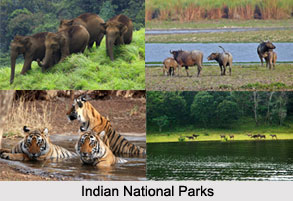 Indian national parks are innumerable and scattered throughout the nation, which have been established to protect the rich variety of wildlife in the country. Indian national parks are also protected from human development and pollution and are declared protected areas of IUCN category II.
Indian national parks are innumerable and scattered throughout the nation, which have been established to protect the rich variety of wildlife in the country. Indian national parks are also protected from human development and pollution and are declared protected areas of IUCN category II.
Indian national parks can be classified according to the regions they are located, like the Northern region national parks, the Western region national parks, the Central region national parks, the Eastern region national parks and the Southern region national parks. India has a large number of 97 national parks at the moment and they are preserving the country`s finest wildlife species, under the supervision of forest departments. Most of these present day Indian national parks were once hunting grounds of the Indian kings and emperors.
National Parks of North India
The first national park in India, Corbett National Park was established in Uttaranchal, in the year 1935. It was established as Hailey National Park, mainly due to the efforts made by famous hunter, Jim Corbett and later was renamed after him. After that, quite a handful of Indian national parks have been built over the years. The Northern region houses some popular national parks in India like the Dachigam National Park, Great Himalayan National Park, Valley of Flowers, Sariska Tiger Reserve, Wild Ass Wildlife Sanctuary, etc.
National Parks of South India
Southern region of India is also home to a large number of national parks with rich diversity. Some of the most notable parks in this region include the Ranganathittu Wildlife Sanctuary, Nagarhole National Park, Bandipur Tiger Reserve, Mudumalai Wildlife Sanctuary, Silent Valley National Park, Eravikulam National Park, Periyar Tiger Reserve, etc.
National Parks of West India
The rich diversity of Indian national parks located in the Western region attracts several nature lovers. The important national parks in this region include the Desert National Park, Marine National Park, Blackbuck (Velavadar) National Park, Gir National Park, etc.
National Parks of East India
The natural diversity or difference in climate conditions is also quite rich in the Indian national parks that are located in the Eastern region of India. Kaziranga National Park, Manas Tiger Reserve, Buxa Tiger Reserve, Jaldapara Wildlife Sanctuary, Sundarbans Tiger Reserve, Simlipal Tiger Reserve, Bhitar Kanika Wildlife Sanctuary, etc. Most of these national parks have earned recognition and reputation around the world, as well.
National Parks of Central India
Central region of India also has several national parks that are serving different purposes. Some of the important ones include the Ranthambore Tiger Reserve, Bandhavgarh Tiger Reserve, Kanha Tiger Reserve, Pench Tiger Reserve, Bori Wildlife Sanctuary and many other national parks.
The rich biodiversity in the Indian national parks and their wonderful maintenance have contributed hugely to the development of eco-tourism in India. The numerous Indian national parks provide natural habitat to several flora and fauna and preserve them. They also provide ample scope for the overall development of the adventure tourism. India is counted among the largest countries of the world by geographical area and it also has one of the richest wildlife. These national parks provide a safe shelter to the numerous migratory birds that arrive in the country to escape the harsh climatic conditions of their native habitats.
Indian national parks are located at diverse geographical locations and have different climatic conditions. While some of them are located in the hilly areas or in the desert areas, there are a few that are situated in the plain lands or mangrove regions. The natural vegetation and wildlife diversity of the national parks also varies.











